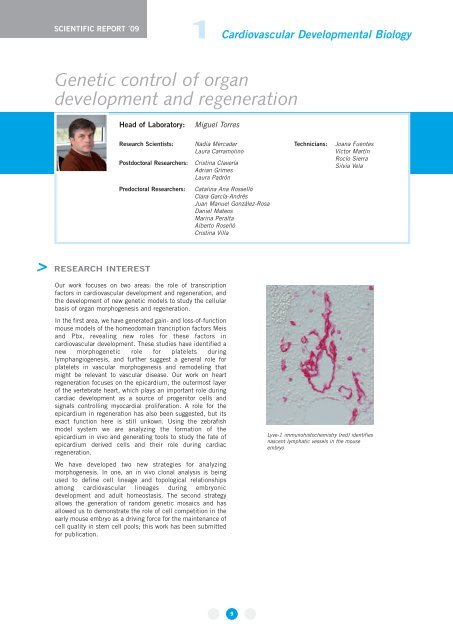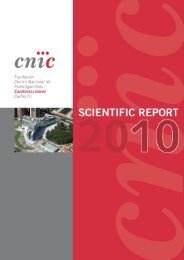Appendix - CNIC
Appendix - CNIC
Appendix - CNIC
Create successful ePaper yourself
Turn your PDF publications into a flip-book with our unique Google optimized e-Paper software.
SCIENTIFIC REPORT ´09<br />
> RESEARCH INTEREST<br />
Our work focuses on two areas: the role of transcription<br />
factors in cardiovascular development and regeneration, and<br />
the development of new genetic models to study the cellular<br />
basis of organ morphogenesis and regeneration.<br />
In the first area, we have generated gain- and loss-of-function<br />
mouse models of the homeodomain trancription factors Meis<br />
and Pbx, revealing new roles for these factors in<br />
cardiovascular development. These studies have identified a<br />
new morphogenetic role for platelets during<br />
lymphangiogenesis, and further suggest a general role for<br />
platelets in vascular morphogenesis and remodeling that<br />
might be relevant to vascular disease. Our work on heart<br />
regeneration focuses on the epicardium, the outermost layer<br />
of the vertebrate heart, which plays an important role during<br />
cardiac development as a source of progenitor cells and<br />
signals controlling myocardial proliferation. A role for the<br />
epicardium in regeneration has also been suggested, but its<br />
exact function here is still unkown. Using the zebrafish<br />
model system we are analyzing the formation of the<br />
epicardium in vivo and generating tools to study the fate of<br />
epicardium derived cells and their role during cardiac<br />
regeneration.<br />
We have developed two new strategies for analyzing<br />
morphogenesis. In one, an in vivo clonal analysis is being<br />
used to define cell lineage and topological relationships<br />
among cardiovascular lineages during embryonic<br />
development and adult homeostasis. The second strategy<br />
allows the generation of random genetic mosaics and has<br />
allowed us to demonstrate the role of cell competition in the<br />
early mouse embryo as a driving force for the maintenance of<br />
cell quality in stem cell pools; this work has been submitted<br />
for publication.<br />
1 Cardiovascular Developmental Biology<br />
Genetic control of organ<br />
development and regeneration<br />
Head of Laboratory: Miguel Torres<br />
Research Scientists: Nadia Mercader<br />
Laura Carramolino<br />
Postdoctoral Researchers: Cristina Clavería<br />
Adrian Grimes<br />
Laura Padrón<br />
Predoctoral Researchers: Catalina Ana Rosselló<br />
Clara García-Andrés<br />
Juan Manuel González-Rosa<br />
Daniel Mateos<br />
Marina Peralta<br />
Alberto Roselló<br />
Cristina Villa<br />
9<br />
Technicians: Joana Fuentes<br />
Víctor Martín<br />
Rocío Sierra<br />
Silvia Vela<br />
Lyve-1 immunohistochemistry (red) identifies<br />
nascent lymphatic vessels in the mouse<br />
embryo



